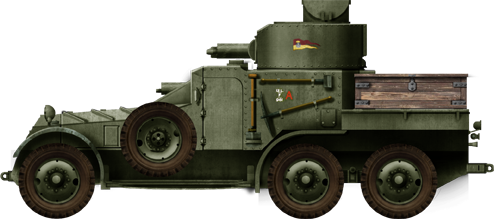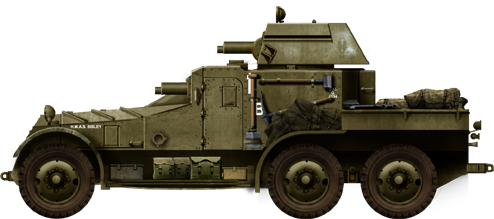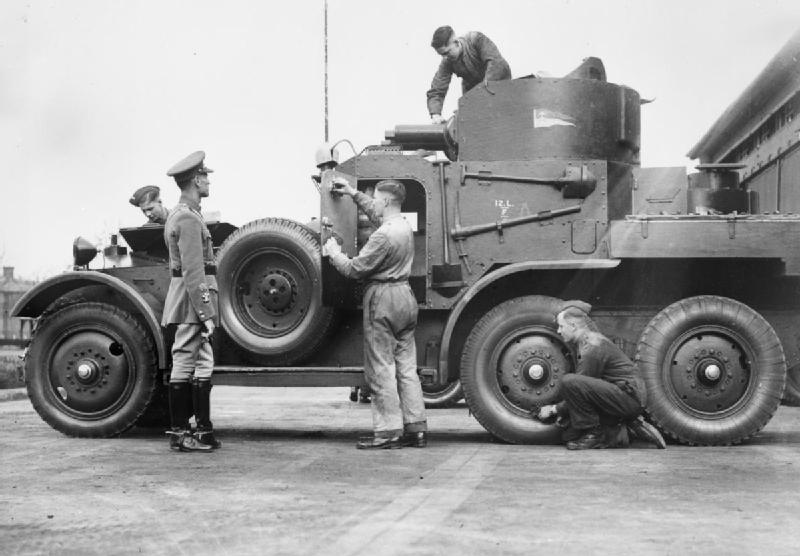A 6x4 armored car for colonial duties
The Lanchester motor company, founder in 1899 and based in Armourer Mills, Montgomery Street, Sparkbrook, Birmingham, was a prolific and recognized car maker. It had produced the famous Lanchester 4x2 armored cars during World War One, which gained a reputation for endurance and reliability, notably on the Eastern and Russian fronts. This time, the War Office requested a 6x4 chassis, for longe range operations in remote provinces of the British Empire, colonies and with the territorial army. Lanchester proposed its design in 1927, and was awarded a contract to build two prototypes on 19 July 1927.Development
These prototypes, D1E1 and D1E2, ready in March 1928, tried different turret shapes and armaments, and the latter had additional driving controls at the rear. But it appeared, during their trials, that their chassis was not strong enough to cope with rugged terrain and make successful cross-country drives. So a second series of 22 vehicles was ordered, the Mk.I and Mk.Ia (command), while two vehicles (two other prototypes D1E3, D1E4) were kept for instruction. Another serie will be ordered later, the Mk.II.Design
The chassis had no civilian car or truck correspondent, as it was purpose-built, and strengthened. It had many similarities with the famous WW1 Rolls Royce armored cars in its body shape, but the twin axles at the rear allowed, in theory, for larger turrets and a roomier fighting compartment, as well as more storage, over the rear-end axle. Two large storage boxes were positioned over the mudguards, right behind the fighting compartment, while a payload could find its way in between. The crew could access the vehicle either through the rear doors, or the side ones, on each side of the fighting compartment. The crew counted a driver, co-driver/commander, and two gunners/loaders. The large, cylindrical two-man turret accomodated one 0.5 in (12.7 mm) and one 0.3 inches (7.7 mm) Vickers liquid-cooled machine guns in a coaxial fashion, or dual mount. The turret was topped by a small observation cupola which could rotate independently. The fighting compartment was extended to the co-driver seat, which could received an additional Vickers 0.3 in (7.7 mm) machine gun. On radio command vehicles (Mk.Ia and Mk.IIa), it was swapped for a No. 9 radio with a whip type antenna, and the co-driver was now in charge of the radio.Production and active service
The Mark I (18 built) had doubled rear tires, and the Mark Ia used a radio instead of the left-hand-side machine-gun. 18 and 4 were delivered, respectively. The seven Mark IIs had single rear tires, a sloped side turret cupola (or a light tank alternative turret), and six command versions were built. First deliveries began in January 1929 with the 11th Hussars, but were finished in 1934. The regimant was relocated in Egypt to replace the 12th Lancers, whereas a squadron of the 12th Lancers was sent, for peacekeeping operations, in the Saar region in 1935. In December, two other squadrons were relocated to Egypt, in response to the Italian invasion of Abyssinia. By 1936 they returned to Great Britain and were re-equipped with more modern Morris LRCs. In 1939, 22 of these Lanchesters were sent to the Far East, affected to the Selangor and Perak battalions of the Federated Malay States Volunteer Force, the Singapore Volunteer Corps, Straits Settlements Volunteer Force and the 2nd Battalion of Argyll & Sutherland Highlanders in Malaya. They took an active part in the Malayan campaign against the Japanese. The others were kept in the Territorial army, 23rd London Armoured Car Company and 1st Derbyshire Yeomanry. In 1940, one was converted as a VIP transport and two were allocated to the 1st Belgian Armoured Car squadron. One is on display at Bovington today.Links about the Lanchester 6x4
The Lanchester 6x4 on WikipediaLanchester 6x4 specifications |
|
| Dimensions | 6.10 x 2.02 x 2.83 m (20 x 6.6 x 9.2 ft) |
| Total weight, battle ready | 7 tons (14,000 lbs) |
| Crew | 4 (driver, co-driver gunner/radio, 2 gunners) |
| Propulsion | Lanchester 6-cyl. petrol, 90 hp (67 kW), 12.9 hp/ton |
| Suspension | 6x4 coil springs, front drive |
| Speed (road) | 72 km/h (45 mph) |
| Range | 320 km (200 mi) |
| Armament | 1 x 0.5 in (12.7 mm) + 2 x 0.303 in (7.7 mm) Vickers |
| Armor | 9 mm front & sides (0.35 in) |
| Total production | 35 |

A Lanchster Mark I of the 12th Lancers. This was a heavily armed vehicle for the time, compared to the Rolls Royce, with a heavy MG and two Vickers medium MGs. The first could destroy light tanks when equipped with AP bullets.

A vehicle of the 12th Lancers, B squadron in Malaya, 1941. This particular vehicle (now on display in a museum) was reequipped with a light tank Mark III turret and had two Vickers 0.3 in machine guns instead of three. The Lanchester 6x4 had good off-road capabilities, and was rugged and reliable, but too heavy and slow for effective operations in reconnaissance units.

A Lanchester Mark IA (command version) of the 12th Lancers, A squadron.

12th Lancers Lanchesters in training.

WW2 Tanks




























WW2 tanks posters

All Tiger tanks liveries.

Panther liveries and variants

WW2 Armour - All tanks











Tanks aces and single tanks series

Find more there

Museums, Movies, Books & Games
The Tanks and Armor in pop culture
Tanks and armored vehicles in general are only really grasped when seen first person: The mass, the scale, it's all there. Explore also the way tanks were covered in the movie industry, in books and in video games.Movies:
Best tanks movie on warhistoryonline.com
On imdb.com
On bestsimilar.com/
miltours.com
liveabout.com/
watchmojo.com
Video Games:
pcgamesn.com
historyhit.com
levvvel.com
vg247.com/best-tank-games
mmobomb.com/
alienwarearena.com

